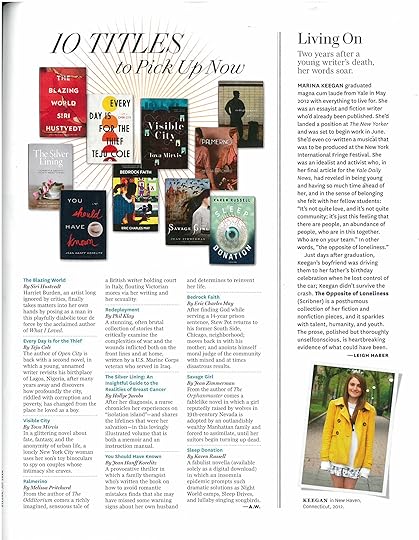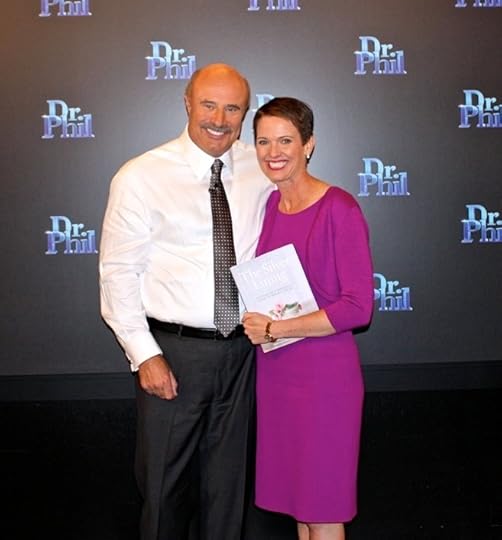Hollye Jacobs's Blog, page 22
March 19, 2014
Silver Lining Quotes: Creativity


The post Silver Lining Quotes: Creativity appeared first on The Silver Pen.
Facebook: https://www.facebook.com/TheSilverPen
Twitter: https://twitter.com/hollyejacobs
Google Plus: https://plus.google.com/1042044534272...
March 17, 2014
Happy Saint Patrick’s Day


Happy Saint Patrick’s Day
Ireland is one of the most beautiful and welcoming places I’ve ever been. The people, the landscape, the music, the architecture…all are magnificent! If you ever get the chance to go, don’t hesitate! You will be be delighted and inspired the whole time! Wishing you a Happy Saint Patrick’s Day!
Here are some photos from Ireland fun facts about the day:
St. Patrick’s Day is observed on March 17 because that is the feast day of St. Patrick, the patron saint of Ireland. It is believed that he died on March 17 in the year 461 AD. It is also a worldwide celebration of Irish culture and history. St. Patrick’s Day is a national holiday in Ireland, and a provincial holiday in the Canadian province of Newfoundland and Labrador.
The actual color of St. Patrick is blue. Green became associated with St. Patrick’s Day during the 19th century. Green, in Irish legends, was worn by fairies and immortals, and also by people to encourage their crops to grow.
St. Patrick’s given name was Maewyn Succat.
The very first St. Patrick’s Day parade was not in Ireland. It was in Boston in 1737. St. Patrick’s Day is celebrated on the 17th because it is the day that he died in 461 AD.
 In Chicago, on St. Patrick’s Day, the rivers are dyed green. Having lived there, this was an annual tradition that we always looked forward to!
In Chicago, on St. Patrick’s Day, the rivers are dyed green. Having lived there, this was an annual tradition that we always looked forward to!
Shamrocks are worn on the lapel on this day. In Gaelic (the Irish language), shamrock means “young clover.”
 Many people wear green on this holiday to avoid being pinched.
Many people wear green on this holiday to avoid being pinched.
St. Patrick did not actually drive snakes out of Ireland; the snakes represent the pagans that he converted to Christianity.

The phrase, “Drowning The Shamrock” is from the custom of floating the shamrock on the top of whiskey before drinking it. The Irish believe that if you keep the custom, then you will have a prosperous year. 
The post Happy Saint Patrick’s Day appeared first on The Silver Pen.
Facebook: https://www.facebook.com/TheSilverPen
Twitter: https://twitter.com/hollyejacobs
Google Plus: https://plus.google.com/1042044534272...
March 14, 2014
The Silver Lining Book Tour!


The Silver Lining Book Tour
At long last, The Silver Lining is being published next week! As a result, I am hitting the road, beginning in New York and moving on to Philadelphia, Nashville, and Phoenix. In April, I’ll be in Chicago, Los Angeles and San Francisco. In May, I’ll be in Charlotte and Dallas. Tired yet?!? My oh my. I’m actually feeling super excited about the opportunity to meet so many of you and to share the book that, I hope, will be a source of support, information and companionship for everyone whose life is impacted by FBC. So, please come visit when you can! In the meantime, here are some photos and some cool stuff that I feel so blessed to have been a part of:
O Magazine picked The Silver Lining as a Top 10 Book for April! On Newstands now.
Taping The Doctors which will air on Monday, March 17th. Was SO FUN!!!
Dr. Phil will air on Monday March 17th! Oh my goodness, he was so kind and warm and wonderful!!!
Chatting with Sandra Mitchell at KCAL in Los Angeles. Here is the interview: http://cbsloc.al/1lTuiAU
Santa Barbara News-Press
There sure are some MAJOR Silver Linings happening around here! Hope to see you all soon!
The post The Silver Lining Book Tour! appeared first on The Silver Pen.
Facebook: https://www.facebook.com/TheSilverPen
Twitter: https://twitter.com/hollyejacobs
Google Plus: https://plus.google.com/1042044534272...
March 13, 2014
Silver Lining Quotes: Stand Up


The post Silver Lining Quotes: Stand Up appeared first on The Silver Pen.
Facebook: https://www.facebook.com/TheSilverPen
Twitter: https://twitter.com/hollyejacobs
Google Plus: https://plus.google.com/1042044534272...
March 12, 2014
The Grand Budapest Hotel


The Grand Budapest Hotel
I’m super duper excited about the new Wes Anderson film that will FINALLY in theaters: The Grand Budapest Hotel.
The Grand Budapest Hotel tells of a legendary concierge at a famous European hotel between the wars and his friendship with a young employee who becomes his trusted protégé. The story involves the theft and recovery of a priceless Renaissance painting, the battle for an enormous family fortune and the slow and then sudden upheavals that transformed Europe during the first half of the 20th century.
According to film critics, however, “Grand Budapest” isn’t just a movie for Anderson aficionados — it’s an accomplished work that deserves attention even from nonbelievers.”
And check out this cast! My oh my… Ralph Fiennes (always dreamy!), Jude Law, Bill Murray, Jason Schwartzman, Saoirse Ronan, F. Murray Abraham, Jeff Goldblum, Willem Dafoe, Adrien Brody, Owen Wilson, Edward Norton, Harvey Keitel, Léa Seydoux, and Mathieu Amalric
Here is the trailer. Prepare to be delighted!
)
The post The Grand Budapest Hotel appeared first on The Silver Pen.
Facebook: https://www.facebook.com/TheSilverPen
Twitter: https://twitter.com/hollyejacobs
Google Plus: https://plus.google.com/1042044534272...
March 10, 2014
The Benefits of Taking A Sabbatical


The Benefits of Taking A Sabbatical
About 12 years ago, I found myself feeling seriously burned out. I was working two jobs (one as a nurse and one at Polo Ralph Lauren) and I was in graduate school. It was a crazy busy and overwhelming time.
The HOTY, who at the time was my boyfriend, suggested that I take a sabbatical. WTF was a sabbatical? I wondered. Dictionary.com defines a sabbatical as “any extended period of leave from one’s customary work, especially for rest, to acquire new skills or training.”
Well, there was NO WAY in the world that I could do that, I thought. My mantra at the time was: work! work! work! Lucky for me, the soon-to-be HOTY was much more zen and enlightened than I was!
He explained that while a sabbatical may seem paradoxical, the reality is that taking periods away from work can actually help you work smarter or develop a new career direction. Much to my surprise, sabbaticals are not about quitting your job and moving to Tibet to become a monk. Quite the contrary, in fact!
The truth of the matter is that sabbaticals mean that you’re not simply on vacation, but choosing not to work while gaining new experiences or refocusing your career. Recent studies attribute everything from a boost in employee retention and higher future productivity for those who take sabbaticals.
There are many other Silver Lining of a sabbatical:
Time for reflection.Opportunity for rejuvenation and renewal.Provides a fresh perspective.Improved morale.Fresh perspectiveStefan Sagmeister gave a powerful TED Talk on Sabbaticals entitled: The power of time off. Hope that you enjoy it and that it helps you consider the possibility.
The post The Benefits of Taking A Sabbatical appeared first on The Silver Pen.
Facebook: https://www.facebook.com/TheSilverPen
Twitter: https://twitter.com/hollyejacobs
Google Plus: https://plus.google.com/1042044534272...
March 7, 2014
The Silver Lining Video

The Silver Lining Video
Only a week and a half before The Silver Lining book arrives! Oh my goodness, I feel the exact same way that I did just before Excitedly Eight was born:
“I’m so ready to be DONE and to birth this thing” (I say “thing” because during my pregnancy, I felt like the impregnated Sigourney Weaver in the movie Alien)
AND “WAIT! HOLD ON! I’m not ready yet. I have so much more preparation to do!”
Well, much in the same way that the baby delivery was inevitable, the delivery of the book is inevitable. Both of which are actually incredible Silver Linings! And, for the record, since her birth, I never once referred to Excitedly Eight as a “thing”.
For all of you who have ordered the book already, THANK YOU. For those of you who haven’t, please consider doing so now. It would mean the absolute world to me.
Today, I’m super excited to share The Silver Lining video with you.
Next week, I will be sharing the book tour schedule (because I’d LOVE to meet you all!) as well as the television appearances.
Here we goooooooo!!!!!
The post The Silver Lining Video appeared first on The Silver Pen.
Facebook: https://www.facebook.com/TheSilverPen
Twitter: https://twitter.com/hollyejacobs
Google Plus: https://plus.google.com/1042044534272...
March 3, 2014
What to Expect at a Breast Biopsy


What to Expect at a Breast Biopsy
A dear friend was on her way to a breast biopsy this morning and text’d me saying that she was scared because she didn’t know what to expect – and that no one had told her about the procedure. This happens with all too much frequency and really gets my goat. Geesh. So much of the fear of this surgical and oncological world comes from the unknown. This is really the fundamental reason that I wrote the book: to give people the support and information to help them through tests, treatment and recovery.
So, please allow me to give you the fundamental basics of what a breast biopsy is and what can be expected during and after the test.
First things first, just because you need a biopsy doesn’t mean that you have cancer. Not all lumps are cancerous. Types of benign (non-cancerous) Lumps include:
fibrosis – firmness in the connective tissuescysts – fluid-filled sacs andbenign breast tumors – non-cancerous areas where breast cells have grown abnormally and rapidly, often forming a solid lumpThe Silver Lining of today is that my girlfriend’s lump was NOT cancerous. So before you get yourself all worked up, please take one step at a time and don’t assume the worst. This is harder said than done, I know…especially coming from the girl whose lump WAS cancerous.
What is a Biopsy
One of the most important things to know is that: A biopsy is the only way to tell for sure if a breast change is cancer. Even though imaging tests like the mammogram and ultrasound can find a suspicious area, they cannot tell whether it’s cancer.
A biopsy removes some cells from the area of concern so they can be checked under a microscope. The cells can be removed using a needle or by doing surgery to take out part or all of the tumor. The type of biopsy depends on the size and location of the lump or suspicious area.
Another important thing to remember is that biopsies are not medical emergencies and can be scheduled at your convenience. Most people want them done asap. I know that I did.
Questions to Ask Before Having a Biopsy
Before having the procedure, I HIGHLY recommend taking a list of questions to your doctor’s appointment so that you can have a full understanding of the what, why, how and when’s of your procedure!
What type of biopsy do you recommend? Why?How does the size of my breast affect the procedure?Where will you do the biopsy?What exactly will you do?How long will it take?Will I be awake or asleep during the biopsy?Can I drive home afterward, or will I need someone to drive me?If the abnormal area cannot be felt, how will you find it?If you are using a wire to help find the abnormal area, will you check its placement by ultrasound or with a mammogram?Can you draw pictures showing me the size of the cut and the size of the tissue you will remove?Will there be a hole there? Will it show afterward?Will my breast have a different shape or look different afterward?Will you put a clip or marker in my breast?Where will the scar be? What will it look like?Will there be bruising or changes in color of the skin?Will I be sore? If so, how long will it last?When can I take off the bandage?When can I take a shower?Will there be stitches? Will they dissolve or do I need to come back to the office and have them removed?When can I go back to work? Will I be tired?Will my activities be limited? Can I lift things? Care for my children?How soon will I know the biopsy results?Should I call you or will you call me with the results?Will you or someone else explain the biopsy results to me?Types of Biopsy Procedures:
Fine Needle Aspiration Biopsy: Fine needle aspiration (FNA) is the least invasive method of biopsy and it usually leaves no scar. You will be lying down for this procedure. First, an injection of local anesthesia (MAKE SURE YOU GET PLENTY OF PAIN MEDICINE!!!) is given to numb the breast. The surgeon or radiologist uses a thin needle with a hollow center to remove a sample of cells from the suspicious area. In most cases, he or she can feel the lump and guide the needle to the right place.In cases where the lump cannot be felt, the surgeon or radiologist may need to use imaging studies to guide the needle to the right location. This is called ultrasound-guided biopsy when ultrasound is used, or stereotactic needle biopsy when mammogram is used.Core Needle Biopsy Core needle biopsy uses a larger hollow needle than fine needle aspiration does. If you have this type of biopsy, you’ll be lying down. After numbing the breast with local anesthesia, the surgeon or radiologist uses the hollow needle to remove several cylinder-shaped samples of tissue from the suspicious area. In most cases, the needle is inserted about 3 to 6 times so that the doctor can get enough samples (mine sounds like a BB gun making a “pop-pop-pop” sound). Usually core needle biopsy does not leave a scar (mine didn’t).If the lesion cannot be felt through the skin, the surgeon or radiologist can use an image-guided technique such as ultrasound-guided biopsy or stereotactic needle biopsy.Vacuum-assisted breast biopsy: Vacuum-assisted breast biopsy is a newer way of performing breast biopsy. Unlike core needle biopsy, which involves several insertions of a needle through the skin, vacuum-assisted biopsy uses a special probe that only has to be inserted once. The procedure also is able to remove more tissue than core needle biopsy does.For vacuum-assisted breast biopsy, you’ll lie face down on an exam table with special round openings in it, where you place your breasts. First, an injection of local anesthesia is given to numb the breast. Guided by mammography (stereotactic-guided biopsy) or ultrasound, the surgeon or radiologist places the probe into the suspicious area of the breast. A vacuum then draws the tissue into the probe. A rotating cutting device removes a tissue sample and then carries it through the probe into a collection area. The surgeon or radiologist can then rotate the probe to take another sample from the suspicious lesion. This can be repeated 8 to 10 times so that the entire area of concern is thoroughly sampled. Vacuum-assisted biopsy is becoming more common, but it is still a relatively new procedure. If you are having this form of biopsy, make sure that the surgeon or radiologist is experienced at using the equipment.Surgical (Open) Biopsy: A surgical biopsy is done by cutting the breast to take out all or part of the lump so it can be looked at under the microscopeAn incisional biopsy removes only part of the suspicious area, enough to make a diagnosis.An excisional biopsy removes the entire mass or abnormal area, with or without trying to take out an edge of normal breast tissue (it depends on the reason for the excisional biopsy).Biopsy Markers: After the doctor has taken out all of the tissue samples needed, a very small, safe marker or clip may be put in your breast at the biopsy site. These clips are tiny, surgical-grade, metal devices that show up on mammograms and are used to mark the biopsy site. The clip cannot be felt and should not cause any problems. It’s used to mark the area in case changes show up on future mammograms.Waiting for Test Results
One of the challenges of testing is waiting for results, which can take anywhere from a few days to a week until the full report is prepared. The waiting time can certainly be fear inducing. It is important to engage in healthy coping mechanisms (deep breathing, yoga, running, meditation, talking with others) to make the time pass. Go ahead and acknowledge the fear and/or anxiety. You’re certainly entitled!
Right after the tissue sample is removed, it’s sent to the lab, where a pathologist looks at it. (A pathologist is a medical doctor who is specially trained to look at cells under a microscope and identify diseases.)
Test Results
If the biopsy result is negative: it means that no cancer was found—the breast change is benign (not cancer). If you have any questions or you feel unsure about the results, you might want to get a second opinion or pathology review. (A pathology review is having another doctor look at your biopsy tissue.) Once you feel comfortable that you do not have cancer, be sure to:
Have regular mammogramsKeep seeing your health care professional for routine breast examsBe aware of any changes in your breasts, and report changes to your doctor right awayTalk with your doctor about your risk of breast cancerIf the biopsy shows that the lump is cancer, the report will tell your doctor some important things about the cancer:
Is it in situ or invasive?In situ means that the cancer started in a duct (tube that carries milk from the lobule to the nipple) and has not spread to the nearby breast tissue or to other organs.Invasive or infiltrating means that the cancer started in a lobule or a duct and has spread into nearby breast tissue. This type may spread to the lymph nodes or to other parts of the body through the lymph system and bloodstream.How fast is it likely to grow & spread? Pathologists use the microscope to look at the cancer cells to see what they look like and how they are arranged. This helps them figure out the cancer’s grade. The grade tells how slowly or quickly the cancer is likely to grow and spread.Is the cancer HER2-positive? Tumors with increased levels of the protein called HER2/neu are called HER2-positive. These cancers tend to grow and spread faster than other breast cancers. HER2/neu testing should be done on all newly diagnosed invasive breast cancers. HER2-positive cancers can be treated with drugs that target the HER2/neu protein.Will it respond to hormone therapy? Estrogen and progesterone receptors respond to the female hormones estrogen and progesterone. On breast cancer cells, these receptors can attach to the hormones which help the cancer grow. Some breast cancers have these receptors (these are called receptor-positive), and others do not (they’re receptor-negative). Finding out if a cancer has these receptors will help your doctor decide if hormone therapy will help you.Be sure you understand your biopsy results and what they mean. Always ask for a copy of the pathology report to keep with your medical records.
Questions to ask about your biopsy results
After your biopsy results are back, it’s important to know if the results are final, definite results, or if another biopsy is needed. Here are some questions to ask if they are the final results:
If it’s not cancer…
Do I need any follow-up?When should I have my next screening mammogram?If it’s cancer…
Is the cancer in situ or invasive?If the cancer is in situ, is it a type of cancer that can become invasive?Does the cancer seem to be growing and/or spreading slowly or quickly?Will the cancer respond to hormone therapy?Do I need more tests to learn the stage of the cancer? (The stage is how widespread the cancer is at the time it’s found.)What kind of treatment do you recommend for me, and why? Are there other options that might work?When will I need to start treatment?Two really good websites (from which I curated most of the information above are the American Cancer Society & Breastcancer.org).
The post What to Expect at a Breast Biopsy appeared first on The Silver Pen.
Facebook: https://www.facebook.com/TheSilverPen
Twitter: https://twitter.com/hollyejacobs
Google Plus: https://plus.google.com/1042044534272...
February 27, 2014
The Years are Short – Suddenly Seven is Now Excitedly Eight!


The Years are Short
The post The Years are Short – Suddenly Seven is Now Excitedly Eight! appeared first on The Silver Pen.
Facebook: https://www.facebook.com/TheSilverPen
Twitter: https://twitter.com/hollyejacobs
Google Plus: https://plus.google.com/1042044534272...
February 26, 2014
If Not Now When? Carpe Diem After Cancer


If Not Now When?
In the past week, we have had several friends who have been afflicted with the most random and debilitating things, everything from falling off a step and breaking an ankle to a nasty cancer diagnosis.
The HOTY (Husband Of The Year) and I have been discussing some big dreams lately – involving things that we have always wanted to do and places we have always wanted to see. These circumstances (and our own!) have led us to ask ourselves a big question: If Not Now, When?
The philosophy that is guiding my post-FBC (f-bomb breast cancer for new readers) life is: Carpe Diem, seize each and every day. This phrase is so NOT a cliché with me. After all, a cancer diagnosis rocked my sense of (im)mortality. Though I worked in hospice and cared for people who were dying, the truth is that I had never been really sick prior to my diagnosis. Even though I was aware of the fact that I was going to die, I just never saw myself in that hospital bed…until I was diagnosed.
What I now know all too well after my professional and now personal experiences is that I don’t know how much time I have. I hope lots, but the thing is, we don’t know. None of us does. Our time is precious, not to be wasted. What I know for sure is that it is not helpful to catastrophize and worry about the future. As a result, I take the action I can now, and I live fully now.
In Randy Pausch’s Last Lecture he shared his words of wisdom about why we need to use our time wisely. He wrote, ”Time is all you have. And you may find one day that you have less than you think.” No truer words have been said.
So, my dear readers, I ask you: If Not Now, When?
PS – By the way, have you seen the video or read the book? If not, please do! It will be an incredible gift in your life!
The post If Not Now When? Carpe Diem After Cancer appeared first on The Silver Pen.
Facebook: https://www.facebook.com/TheSilverPen
Twitter: https://twitter.com/hollyejacobs
Google Plus: https://plus.google.com/1042044534272...














